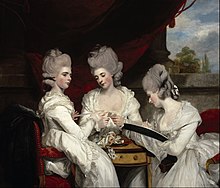Tambour lace
This article needs additional citations for verification. (August 2019) |

Tambour lace refers to a family of lace made by stretching a fine net over a frame[1] (the eponymous Tambour, from the French for drum) and creating a chain stitch, known as tambour, using a fine, pointed hook[2][3] to reach through the net and draw the working thread through.
The tambour embroidery technique became popular in western fashion during the 18th century, particularly fashionable in the early 19th century when applied to net fabrics, creating a look similar to lace.[4]
History and origins
[edit]Tambour chain-stitch embroidery was adapted from techniques used extensively in the East, namely Persia, India, and China, which had been practiced for many centuries. Tambour embroidery has its origins in Ari work of the Kutch region of Gujarat, India, and chain stitch practiced in China.[5]

Highly decorated textiles and garments of the in heavier weight fabrics featuring tambour-style embroidery, such as jackets, waistcoats, and gowns, were created for the export market in countries including India in the 18th century. Pieces in imitation began to be manufactured in the west at this time due to the rising popularity of imported garments, using adapted embroidery techniques .[6]
Little is heard of tambour lace until the 1760s when translucent muslins from India, perhaps already tamboured with sprigs, were coming into fashion.

In the second half of the 18th and into the early 19th century, tambouring was a fashionable pastime for ladies of the French and English courts.[4] It was usually practiced on fine muslin, therefore becoming associated with lace, and was variously known as sewed muslin and flowered muslin.
In fashionable western dress, lightweight textiles made-up into garments and accessories were popular through the late 18th to the mid-19th century. Simple chain stitches of the tambour technique embellished clothing with cotton, silk, and silver guilt thread, as well as elements such as beads and sequins.[5] Floral motifs and trailing forms reflected the Asian origins of the embroidery style, though much of the tambour work produced for the western market was manufactured in areas such as western Scotland, for example.

Those creating tambour-worked pieces in Britain, both in past-time and in industry for market sale, worked using a circular embroidery frame, adapting techniques from practitioners in India where traditionally tambour-work was created using only the hands.[6] Later examples of the tambour technique were created using machine, through technological development, with hand-made tambour-work, including tambour lace, being recognised as an artisanal craft.[5]
Although tambour is often a surface embroidery, it is used in Limerick lace.[7]
See also
[edit]References
[edit]- ^ Willem. "Tambour Frame". trc-leiden.nl. Retrieved 2021-07-10.
- ^ "Tambour embroidery".
- ^ Willem. "Tambour Lace". trc-leiden.nl. Retrieved 2021-07-10.
- ^ a b Bentley, Grace Victoria. "The History and Development of Tambour Embroidery".
- ^ a b c "Tambour: A (not so) brief History |". 2023-06-30. Retrieved 2023-07-30.
- ^ a b Waistcoat, 1740–1749, retrieved 2023-07-30
- ^ Pat Earnshaw (1984). A Dictionary of Lace. Shire Publications. ISBN 0-85263-700-4.

